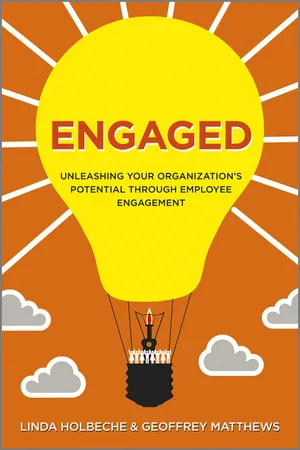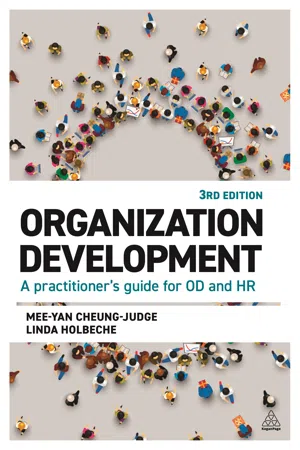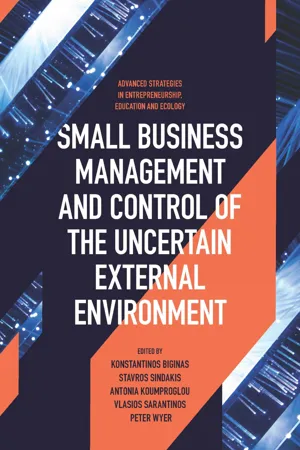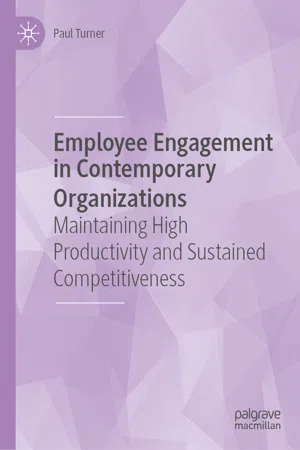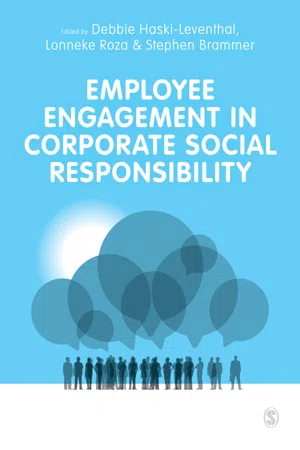Employee Engagement
Employee engagement refers to the emotional commitment and involvement employees have towards their organization's goals and values. Engaged employees are enthusiastic about their work, leading to higher productivity, better customer service, and lower turnover rates. Businesses often use various strategies, such as open communication, recognition programs, and opportunities for growth, to foster employee engagement.
7 Key excerpts on "Employee Engagement"
- eBook - ePub
Engaged
Unleashing Your Organization's Potential Through Employee Engagement
- Linda Holbeche, Geoffrey Matthews(Authors)
- 2012(Publication Date)
- Jossey-Bass(Publisher)
...Some focus on what drives engagement, while others consider the effects of engagement. Some look at specific players involved, such as the role of the supervisor, or the part played by top management; other definitions consider the state of engagement, or how it feels to be engaged. In the following sample of definitions, some of the differences of emphasis are obvious. Employee Engagement is: the individual’s involvement and satisfaction with, as well as enthusiasm for, work (Harter et al., 2002) employees’ relationship with the organization, its leadership and their work experience (Towers Watson, 2008) a heightened emotional and intellectual connection that employees have with their job, organization, manager and co-workers (The Conference Board, 2006) a positive attitude held by the employee towards the organization and its values (Robinson et al., 2004) a set of positive attitudes and behaviours enabling high job performance of a kind that is in tune with the organization’s mission (Storey et al., 2008) the connection and commitment that employees exhibit towards an organization, leading to higher levels of productive work behaviours (Vance, 2006) the extent to which employees commit to something or someone in their organization, how hard they work, and how long they stay as a result of that commitment (Corporate Leadership Council, 2004). In other words, engagement is both a cause and effect. It involves a relationship between the organization and the employee. It builds on several more familiar workplace concepts such as employee commitment, job satisfaction and organizational citizenship; however, engagement goes beyond all of these since it connects these positives with improving business outcomes and performance...
- eBook - ePub
- John Gennard, Graham Judge, Tony Bennett, Richard Saundry(Authors)
- 2016(Publication Date)
- CIPD - Kogan Page(Publisher)
...MacLeod and Clarke, in their influential 2009 review ‘Engaging for success: enhancing performance through Employee Engagement’, identified fifty different definitions. They argued that Employee Engagement encompasses: unlocking people’s potential at work and the measurable benefits of doing so for the individual employee, the organisation and the UK economy retaining and building on the commitment, energy and desire to do a good job to maximise individual and organisational performance making the employees’ commitment, potential creativity and capability central to the operation of the organisation – it is how people behave at work that can make the crucial difference between business success or failure enabling people to be the best they can at work, recognising that this can only happen if they feel respected, involved, heard, well-led and valued by those they work for and with employees’ having a sense of personal attachment to their work and organisation – they are motivated and able to give their best to help it succeed, and from this will flow a series of positive benefits for the organisation and the individual ensuring that employees are committed to their organisation’s goals and values, are motivated to contribute to organisational success and are able at the same time to enhance their own sense of well-being providing clear evidence of trust and fairness based on mutual respect through which two-way promises and commitments between employees and management are understood and fulfilled. Some commentators see Employee Engagement as a set of approaches or strategies designed to elicit organisational commitment. However, for others, Employee Engagement is an outcome of managerial actions and activity (see for example Purcell, 2012). Acas (2014) suggest that Employee Engagement describes the positive attitude or behaviour of someone at work...
- eBook - ePub
Organization Development
A Practitioner's Guide for OD and HR
- Mee-Yan Cheung-Judge, Linda Holbeche(Authors)
- 2021(Publication Date)
- Kogan Page(Publisher)
...Producing a satisfied and committed workforce is a worthy aim but on its own it is not enough. Satisfied employees may be happy but make little contribution to the organization; committed employees may be focusing on the wrong objectives. While definitions vary, most agree that Employee Engagement is a vital driver of improvement and higher performance as this definition by the Institute for Employment Studies (IES) suggests: [Engagement is]... A positive attitude held by the employee toward the organization and its values. An engaged employee is aware of business context and works with colleagues to improve performance within the job for the benefit of the organization (Robinson et al, 2004). The state of Employee Engagement is generally characterized by what Csikszentmihalyi (1990) describes as ‘flow’ – where people are so pleasurably immersed in their work that they freely release their ‘discretionary effort’. This feeling of commitment, passion and energy translates into high levels of persistence with even the most difficult tasks, leading people to exceed expectations and take the initiative. Surveys also show that engaged employees see their work as more meaningful and fulfilling. Engaged employees are more productive, more service-oriented, less wasteful, more inclined to come up with good ideas, take the initiative and generally do more to help organizations achieve their goals than people who are disengaged. Moreover research shows that engaged employees tend to be more resilient too. However, at the other end of the engagement spectrum is burnout (Maslach et al, 2001). Some employees may be so engaged (and also perhaps driven, ambitious or insecure) that they overwork for extended periods and end up damaging their health. Employers have a duty of care to prevent this from happening and employee well-being is a critical element of any engagement strategy...
- Konstantinos Biginas, Stavros Sindakis, Antonia Koumproglou, Vlasios Sarantinos, Peter Wyer, Konstantinos Biginas, Stavros Sindakis, Antonia Koumproglou, Vlasios Sarantinos, Peter Wyer(Authors)
- 2022(Publication Date)
- Emerald Publishing Limited(Publisher)
...The result is that the staff is committed to their organisation’s goals and values, motivated to contribute to organisational success, with an enhanced sense of their own well-being (Engage for Success, 2010a, 2010b). The concept was first introduced by Kahn (1990), who defined engagement as the harnessing of organisational members to their work roles. Kahn (1990) further developed the theory of psychological conditions of personal engagement and disengagement at work which conceptualises how people interact with their work roles and express themselves physically, cognitively and emotionally. Robinson, Perryman, and Hayday (2004) define Employee Engagement as ‘a positive attitude held by the employee towards the organisation and its values’ and they highlight that an engaged employee understands the business and is actively involved in improving performance through team work for the benefit of the organisation. Truss, Delbridge, Alfes, Shantz, and Soane (2013a, 2013b) interpret the term as ‘being positively present during the performance of work by willingly contributing intellectual effort, experiencing positive emotions and meaningful connections to others’. Engagement, going to the heart of the workplace relationship between employee and employer, can be a key to unlocking productivity and to transforming the working lives of many people (MacLeod & Clarke, 2009). Ajayi, Odusanya, and Morton (2017) stated that small enterprises are the backbone of modern economies. They are vital to sustained long-term economic growth, and constitute a vibrant and growing sector in most advanced economies across the globe (Levy & Powell, 2005). While they play a significant role in employment generation, revenue generation and export earnings in developing and emerging economies (Javalgi & Todd, 2011), they are often faced with limited resources which impair their access to new innovation (Verheugen, 2003)...
- eBook - ePub
Lean Implementation
Applications and Hidden Costs
- Frances Alston(Author)
- 2017(Publication Date)
- CRC Press(Publisher)
...There have consistently been links between employees who are engaged in the workplace and the effectiveness of the support they provide to their companies to achieve their business objectives. These links have been demonstrated through research by various scholars and practitioners. Some of these links will be highlighted and referenced in this chapter. Employees who are engaged are instrumental in shaping the culture of an organization and can guide the success of the organization. Managers must keep in mind that in today’s business environment, Employee Engagement can drive success or failure across the business. 4.2 Defining Employee Engagement Many theorists and practitioners struggle with attaching a definition to Employee Engagement; however, many of them agree that having employees participate in workplace activities is of great importance for organizational success. When speaking of Employee Engagement, reference is being made to employees who are involved in providing inputs into decisions and having the ability to comment on the decision and suggestions of others. Based on the literature about Employee Engagement (Vignette 4.1), one can surmise that in order for employees to allow themselves to be engaged in work activities, there must be an emotional connection and an intellectual commitment with the organization that fuels the desire to help the organization succeed. In order to know how to address Employee Engagement in an organization, it is necessary to know what constitutes engagement by employees and how to encourage and improve engagement. VIGNETTE 4.1 A literature review on the importance of various ways in which practitioners and theorists define Employee Engagement can be viewed in the following articles: Markos, S...
- eBook - ePub
Employee Engagement in Contemporary Organizations
Maintaining High Productivity and Sustained Competitiveness
- Paul Turner(Author)
- 2019(Publication Date)
- Palgrave Macmillan(Publisher)
...The breadth and depth of interpretations about Employee Engagement means that it resonates across multiple disciplines from psychology to sociology to management science and organisational behaviour. Influencing factors from each of these areas have an impact on how the constituent parts of the concept are perceived. Hence Employee Engagement can be summarised as: A state of being which includes vigour, dedication, and absorption Which encompasses satisfaction, enthusiasm, involvement and commitment —the simultaneous employment and expression of a person’s preferred self Is part of a wider employee ‘experience’ Which in turn creates employees who are mentally and emotionally invested in their work—leading to a state of fulfillment in employees and increased discretionary effort It consists of cognitive, emotional, and behavioral components that is associated with individual role performance But also includes the inclination or orientation to experience the world from a particular vantage point It is influenced by the level of resources, including personal resources such as resilience, and organisational resources required to energize and motivate employees (and counteract hindrance demands, such as overly intense work, de-energize employees and deplete levels of engagement) It is dependent on contextual elements created by the team or organisational environment And is increasingly seen as part of a broader approach. to workforce management (Bailey 2016). As organisations strive to improve levels of engagement, a critical starting point will be to reach a consensus about what is meant by the term as it applies to their own unique context. There is little guidance about a best practice approach to support them because of the many variations and interpretations. Instead of best practice therefore, a best fit approach is one that has been adopted. Chapter 3 will explore how this is manifested in practice...
- Debbie Haski-Leventhal, Lonneke Roza, Stephen Brammer(Authors)
- 2020(Publication Date)
- SAGE Publications Ltd(Publisher)
...3 Development of Employee Engagement through CSR Andy Kidd, Thomas Maak, Nicola Pless, and Howard Harris Overview Employee Engagement is important as it can affect productivity, commitment and personal satisfaction, however many employees are not engaged or disengaged with their work. Corporate social responsibility (CSR) is used by organisations to engage their workforce and retain talent. This chapter explores the relationship between Employee Engagement and CSR. It outlines related concepts and the history of research in Employee Engagement. It explores the role of employees as implementers of CSR, not only as volunteers but also as part of a programme of employee-led CSR. It shows that a strong and positive link can be established between Employee Engagement and CSR, and considers the ways in which Employee Engagement may be used to enhance the achievement of both corporate and individual goals, although this will not be achieved where CSR is not well integrated in the organisation and employees view CSR as window-dressing. The chapter concludes by outlining some opportunities for further research. Learning objectives By the end of this chapter, readers should be able to: describe Employee Engagement theory development, operation and refinement describe ways in which Employee Engagement may benefit individuals and organisations show how ideas of CSR have changed over time describe CSR and Employee Engagement through ‘employee as implementer and job crafter' demonstrate how CSR can lead Employee Engagement. Introduction In this chapter, we explore the relationship between Employee Engagement and corporate social responsibility (CSR). According to a recent Gallup poll (Harter, 2018), almost 70% of employees in the USA are not engaged at work. At the same time, companies are seeking to attract the best talent – and have trouble doing so...
